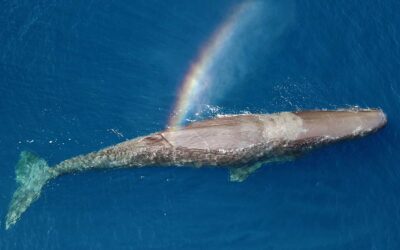Let’s start with WildTrack, founded by Zoë Jewell and Sky Alibhai. After working on a long-term project with rhinos in Zimbabwe, they decided to establish WildTrack. Their organization focuses on the crossroads of Indigenous knowledge and the use of AI, aiding in non-invasive monitoring of species and populations. Their FIT (footprint identification technology) method is currently being trained to recognize more and more species and so their progress is ever moving forward.
Technology is also used by Inverto, an organization led by Cameron Dowd and Jürg Germann. Their backgrounds in engineering and the usage of drones in health quests have led them to the biodiversity crisis we are currently in. Nothing is too crazy for Cameron and Jürg, from drone-based seed dispersal to training locals to fly these magical birds for monitoring purposes.
Niklas Storm takes us on a trip to Uganda, where he photographed gorillas and other beautiful species. His photographs transport us to this completely wild world, where humans are vulnerable and Mother Nature rules.
In the Mistbelt Forests in South Africa, a special kind of parrot can be found: the Cape Parrot. Susan Wishart is the Project Manager in Hogsback and oversees all research and conservation efforts, from crochet parrots to seed collection and from community-run nursery stands to the eradication of invasive species. All for the conservation of the Cape Parrot.
If you want to know more about the value of a forest, you should read what Gyula Bózsó has to say. Coming from the Bükk Mountains in Hungary, he knows everything about food that comes straight from the forest. Healthy, sustainable, AND delicious. And the best thing? This article includes a recipe with European bladdernut, so you can immediately try out the taste of the forest yourself.
Chris D’Agorne takes us into the process of rewilding your own land. It doesn’t have to be big, but if you give it time, love, and care, any piece of nature, of land, can grow into a world on its own. After years of caring for his own plot of land, he now has a space where he can go to clear his mind or to spend time with his son. And that isn’t all. By creating this space of biodiverse nature, he has also created a legacy that will last forever.
How hard is it to try and save a species that is literally on the brink of extinction, in a country where conservation of nature isn’t the number one priority? Pretty hard. Nevertheless, Morteza Pourmirzai and Atie Taktehrani are doing everything in their power to save the Iranian Cheetah. The public has started to understand its urgency, and so projects are becoming bigger and more effective than they have ever been. But will it be enough to save the species from extinction?
Poaching is a sad business. Rangers arrive on crime scenes daily, presented with another lost life. But who says we can’t conduct research on these crime scenes, just like we do with humans? Wildlife Forensic Fund and the Wildlife Forensic Academy and here to change that. By educating rangers, veterinarians, and others who could arrive at such crime scenes, they increase the chance of catching the killers. CSI in the wildlife scene is now a real thing, and it’s incredibly exciting.
Issue 10 also includes a fantastic infographic about the most endangered places around the world, and about a species you might have never heard about, the Numbat.
Are you ready to dive into all these stories? Then go check out issue 10!



